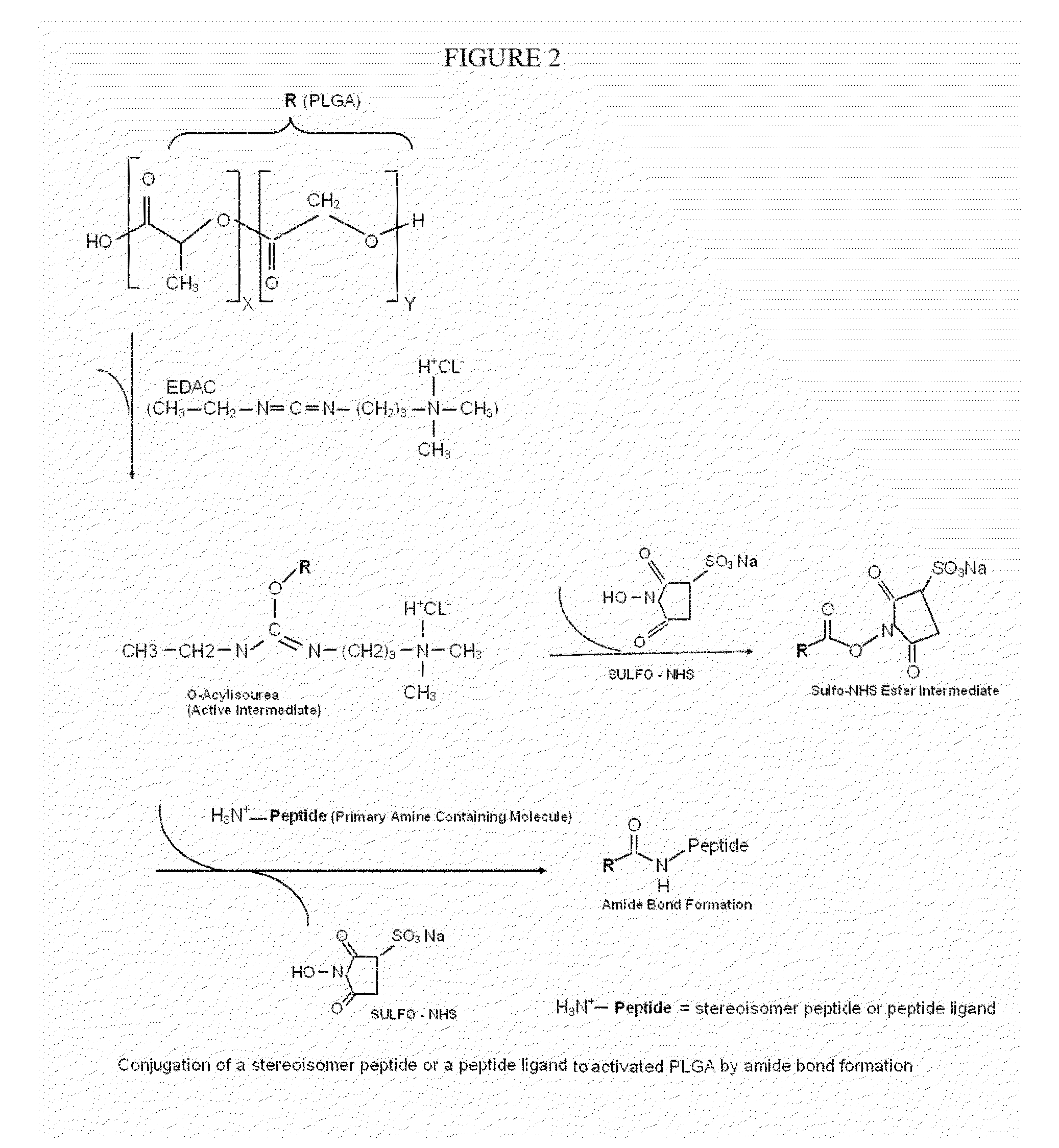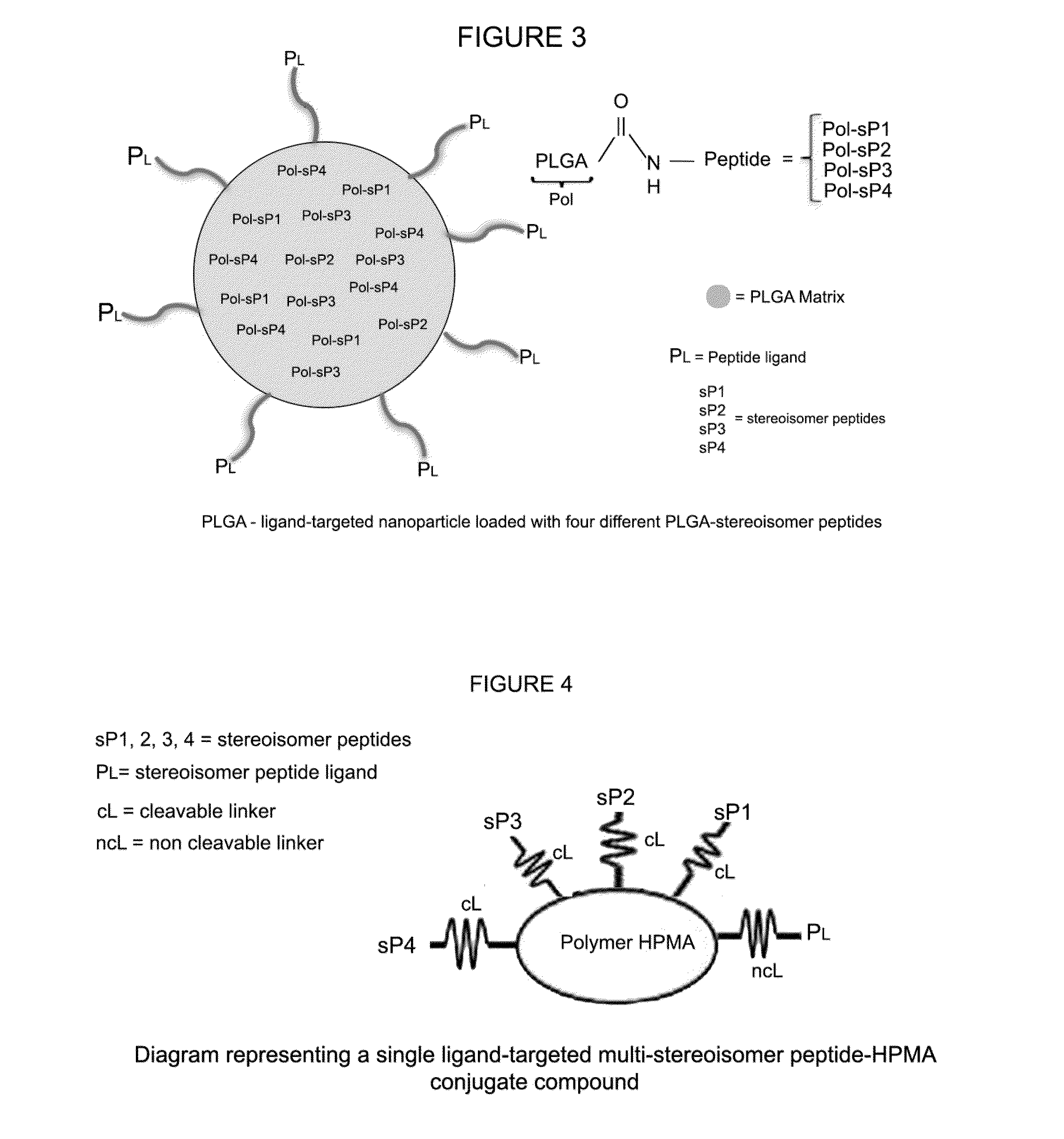Stereoisomer peptides, their polymer conjugates, their encapsulation into nanoparticles, and uses thereof for the treatment of diseases caused by abnormal angiogenesis.
a technology of peptides and peptides, applied in the field of single therapeutic ligand targeted multi-stereoisomer peptide polymer conjugate compounds, can solve the problems of poor recovery of adult central nervous system (cns) from damage, secondary damage to host tissues, and high risk of chronic inflammation, and achieve the effect of suppressing, eliminating, blocking, or disrupting the physiological activity and/or the conformational structure of the target protein
- Summary
- Abstract
- Description
- Claims
- Application Information
AI Technical Summary
Benefits of technology
Problems solved by technology
Method used
Image
Examples
example 1
Synthesis of Stereoisomer Peptides
[0248]Stereoisomer peptides of the naturally occurring sequence are prepared with D-isomers using standard solid-phase synthesis methods except that in the case of retroinverso peptides the synthesis is started backwards (i.e. all the amide bonds are reversed). Peptide synthesis was carried out at the 100 uM level. At the N-terminus, a lysine was added for later use (i.e., conjugation to a polymer) and the ε-amine group was protected by acetylation. The E (epsilon) group was later deprotected after synthesis to mimic the attachment point that was used to conjugate directly the peptide to an activated carboxyl group of polymer or to the free carboxyl group of the end terminal residue of a linker attached to the polymer. An acid sensitive resin (Cl-Trt), preloaded with the C-terminal amino acid is used to allow for the isolation of side-chain protected peptides. Briefly, N-alpha-Fmoc and side-chain protected D-amino acids are activated using HCTU [O-(...
example 2
Cyclization of Peptides
[0249]Cys residues were added at both N or C termini of the synthesized stereoisomer peptide to allow cyclization and the formation of a disulfide bond by oxidation of the Cys residues using the oxidizing agent DMSO or iodine (I2) which dissolves the SH-group containing stereoisomer peptide (1 mg / ml or less) in a phosphate or bicarbonate aqueous buffer at pH 7-9. DMF, methanol or water with a proton scavenger such as triethylamine or diisopropylethylamine can also be used. The cyclized stereoisomer peptide was purified using high performance liquid chromatography (HPLC). The cyclo peptide eluted earlier than the uncyclized precursor due to the diminished available hydrophobic surface area in the cyclized peptide, which minimizes its interaction with the reversed phase matrix. The cyclization takes from 15 minutes to 24 hours depending on the specific conditions used (i.e. room temperature, solvent, stereoisomer peptide composition, and solubility). The reactio...
example 3
Activation of PLGA and Preparation of PLGA-Stereoisomer Peptide Conjugates
[0250]PLGA can be obtained commercially from several suppliers, or synthesized by random ring-opening co-polymerization of glycolic acid and lactic acid. PLGA is reacted with 1-Ethyl-3-(3-dimethylaminopropyl)carbodiimide (EDAC), a water soluble carbodiimide usually obtained as the hydrochloride, to obtain the active intermediate O-acylisourea, which in the presence of Sulfo-NHS (N-hydroxysulfosuccinimide) form a sulfo-NHS ester intermediate. NHS enables control and modification of carbodiimide crosslinking reactions involving activation of carboxylates (—COOH) for conjugation with primary amines (—NH2). The Sulfo-NHS ester intermediate reacts with the primary amine (—NH2) of a stereoisomer peptide allowing an amide bond formation and the release of Sulfo-NHS. This creates a PLGA-peptide conjugate (see FIG. 2).
PUM
| Property | Measurement | Unit |
|---|---|---|
| diameter | aaaaa | aaaaa |
| sizes | aaaaa | aaaaa |
| sizes | aaaaa | aaaaa |
Abstract
Description
Claims
Application Information
 Login to View More
Login to View More - R&D
- Intellectual Property
- Life Sciences
- Materials
- Tech Scout
- Unparalleled Data Quality
- Higher Quality Content
- 60% Fewer Hallucinations
Browse by: Latest US Patents, China's latest patents, Technical Efficacy Thesaurus, Application Domain, Technology Topic, Popular Technical Reports.
© 2025 PatSnap. All rights reserved.Legal|Privacy policy|Modern Slavery Act Transparency Statement|Sitemap|About US| Contact US: help@patsnap.com



